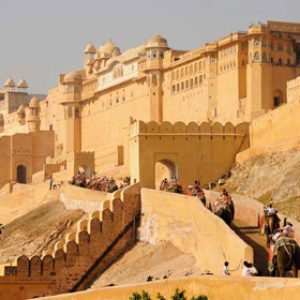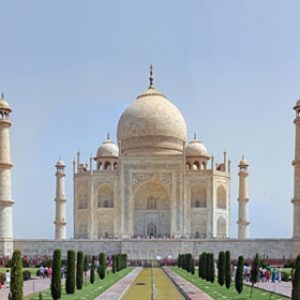Chittaurgarh (Chittorgarh) is among the most historic fort city in the Indian state of Rajasthan. In every tour itinerary to this part of India, a visit here is generally included. The reason for this is the rich history and cultural heritage of the city that is wrapped around with elements of chivalry, tragedy and Romanticism. The majestic Chittaurgarh Fort in here was the pride of erstwhile Rajput kings who ruled over here and stood mighty and proud even after facing several wars and attacks from enemy battalions. There are numerous minarets, forts, palaces and temples in and around Chittaurgarh which are a must-visit.Area: 28 sq km
Location: On the banks of Berach and Gambhiri rivers
How to Reach:
By Air- Maharana Pratap Airport, also known as the Dabok Airport, in Udaipur is the nearest airport to reach Chittaurgarh. The airport is located at a distance of 90 km. At the airport; there are taxis and cabs available to move in and around the city.
By Rail- Chittaurgarh Railway Station is well-connected with major cities via an extensive rail network. Local transportation is also available to carry visitors from railway station to in and around attractions of the district.
By Road- One can also reach Chittaurgarh via road. There is proper road connectivity available, thus, frequent bus service also plays crucial role in carrying tourists from nearby cities. Private taxis and cabs are also available for hire. Some of the major distances from Chittaurgarh are Ajmer – 185 km, Jaipur – 304 km, and Indore – 349 km.
Best time to Visit: October – March
Language Spoken: Hindi, English and Rajasthani
Famous Delicacies: Daal Baati Choorma, Pyaz ki Kachori, Baajre ki Khichdi, Mirchi Vada, Lahsun ki Chutney, Besan ke Gatte ki Sabzi, and more.
History
The origin of Chittaurgarh can be traced to the seventh century. Earlier it was known as Chitrakut, after a local Rajput chieftain named Chitrang. It remained the capital of the local Sisodia clan of Rajputs from the eighth to the 16th century.
The history of this town is written in blood and sacrifice. Muslim rulers sacked it three times in the medieval period. The first was by Ala-ud-din Khilji, the Sultan of Delhi in 1303. Khilji laid siege of this hill fort to capture the beautiful Padmini, the queen of Chittaurgarh.
When the situation worsened, Bhim Singh, the ruler of Chittaurgarh, led his men donned with saffron robes of sacrifice, and rode out of the fort to certain death. Inside the fort, women, including Padmini and the children, committed mass suicide or jauhar by immolating themselves on a huge pyre, rather than losing their honor at the hands of the enemy.
In the middle of the 15th century, Chittaurgarh gained eminence when the legendary Rajput ruler, Rana Kumbha, ruled it. He built the Vijay Stambh (Victory Tower) to commemorate his victory over Mahmud Khilji, the ruler of Malwa, in 1440.
Bahadur Shah, the Sultan of Gujarat, sacked Chittaurgarh again in 1535. The jauhar that followed the siege saw the death of 13,000 women and 32,000 Rajput soldiers.
The third and final siege took place in 1568 at the hands of the great Mughal emperor Akbar. Jaimal and Kalla, two Rajput generals, valiantly defended the fort but with their death and deteriorating situation, jauhar was performed. However, Maharana Udai Singh II, the ruler of Chittaurgarh, fled to Udaipur and re-established his rule. The Mughal emperor Jahangir returned Chittaurgarh to its rulers in 1616.
Culture of Chittaurgarh
Chittaurgarh, ‘Land of Braves’, is one of the major destinations in Rajasthan that witnesses huge footfall from all parts of the globe. One can find ladies dressed in traditional Ghagra-Choli, ethnically accessorized with beautiful silver pieces of jewelry. The population of Chittaurgarh includes people of all religions, such as Hinduism, Sikhism, Christianity and Islam. The city is also praised for promoting folk dance & music, and various cultural activities. Additionally, Chittorgarh also presents the perfect mix of age-old traditions and modern style of living. Locals are friendly and extend warm hospitality. Numerous festivals and fairs also mark a distinctive identity of Chittaurgarh city.
Shopping in Chittaurgarh
Chittaurgarh (Chittorgarh) is a paradise for indulgent shoppers. Exquisite handicrafts, fabrics, shoes and metal ware are some of the collectibles. Camel leather jutis, beautiful Thewa Jewelry (unique gold designs embedded in glass) and Akola fabrics are some of the obvious takeaways to be included in every shopping list. Do not miss to buy some wooden painted toys from Bassi village. These toys can be used as gifts and souvenirs. Some of the popular shopping centers in Chittaurgarh are Rana Sanga Market, Fort Road Market, Station Circle, Sadar Bazaar, New Cloth Market, and Gandhi Chowk.










